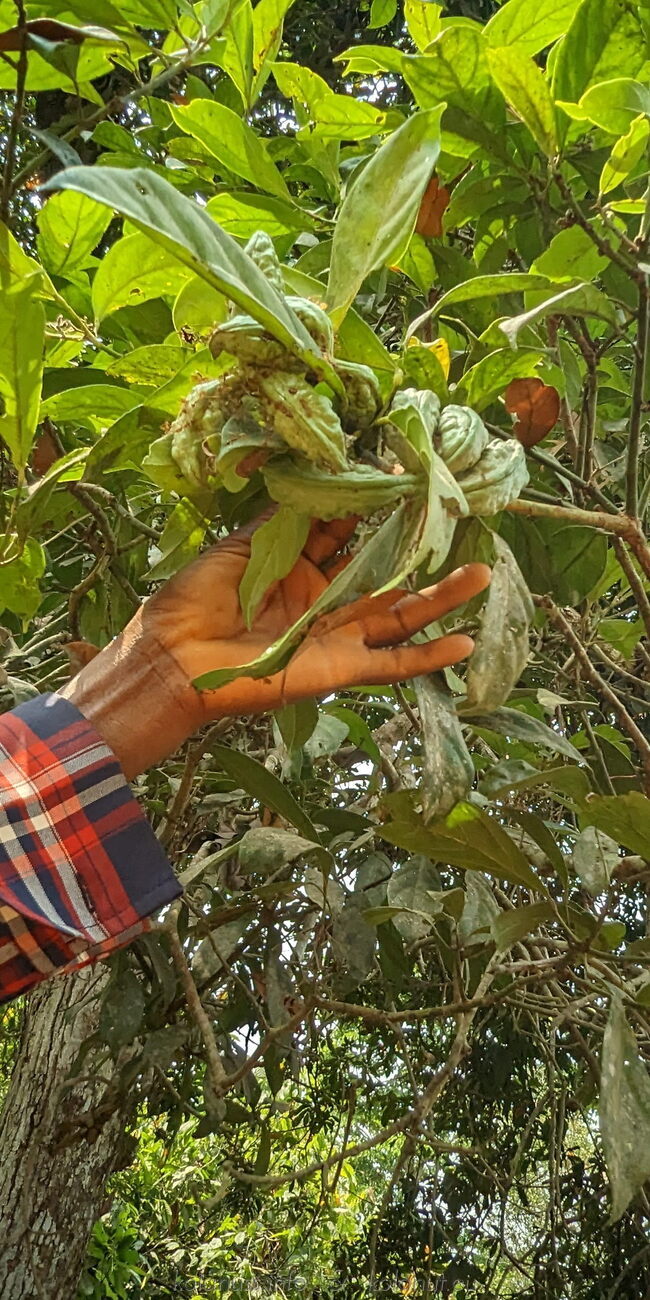Ants protect the fruits from pests by spinning webs around them. Nevertheless, the kola nut has enemies such as the kola beetle, moth larvae, and a type of mistletoe.
Flowers
The flowers have a faint scent and are arranged in umbel-like inflorescences. The ratio of male to female flowers varies greatly between the inflorescences and from tree to tree. The female flowers are morphologically hermaphroditic, as they have five curved, fleshy stigmas that lie above the ovaries, but on the edges of which there are also two rows of ten rudimentary stamens. Functionally, however, it is a female flower, so the terms hermaphroditic and female can be used synonymously when it comes to kola. In male flowers, the anthers are fully developed and provide yellowish, slightly sticky pollen.
Both sexes occur on the same tree, meaning that the kola is monoecious, and can self-fertilize to increase the survival and propagation chances of the kola. However, the seeds produced become infertile after several inbred generations without genetic exchange.
Fruits
The fertilized flowers develop into five-part, star-shaped fruits with a dark green, thick, and leathery shell. These follicle fruits are also called aggregate fruits.
When the kola fruit is opened with a machete, as is traditionally done, 5-12 chestnut-sized, deep red, pink, or cream-white seeds in a white skin, the seed coat or testa, are revealed. In this state, freed from the outer and inner shells and fresh or slightly pre-dried (English: "cured"), they are consumed by the local population of West Africa and are easy to chew.
The inner seeds have a fleshy seed coat, also called arillus or sarcotesta. This skin can be easily removed after soaking in cold water for about 15 minutes, revealing the colorful and caffeine-containing seeds. The seeds of Cola nitida have two cotyledons. Removing the seeds from the shell reveals a dividing line that runs between the two parts of the seed and along which they can be easily broken open. If the seed is allowed to germinate, the sprout emerges from the top end of the seed from the joint of the two halves. The other well-known kola species, Cola acuminata, can have between one and seven cotyledons.
Beneficial Insects, Pests, and Parasites
Like most plants that produce psychoactive substances, the kola nut has developed caffeine as a defense against predators due to evolutionary pressure. Caffeine is a natural insecticide and is meant to protect the seeds of the plant from being eaten and contaminated.
Nevertheless, the kola nut has some successful enemies. These include Balanogastris kolae, the kola beetle, Sophrorhinus gabanjaensis, another beetle known as a stem borer, Characoma strictigrapta, a moth (or its larvae), and Sahlbergella, a beetle species that normally attacks cocoa but also does not spare the related kola. These are particularly adapted to their food, and so pregnant females can easily eat their way into the shell or crawl into existing holes and lay their eggs inside the follicle fruits. There, the larvae eat the seeds before starting a new reproductive cycle. Therefore, one of the most important methods to avoid crop failures due to pest infestation is regular inspection and the quick removal of infested fruits.
In their natural habitat, the tropical forest, or in permacultures, ants live that protect the fruits of the kola trees during their ripening by catching harmful insects and feeding on them. They often build their nests high in the forked branches of the trees and are found in large numbers on the trees, where they spin webs around the fruits to catch pests.
Additionally, a type of mistletoe grows in the branches of the trees. These plants, known as "Krampas" in Ghana, are thoroughly cut out of the trees because they drain so much energy and potential for photosynthesis from the tree by thinning the crown that entire harvests can fail.
Termites can also become a problem when they gnaw on the roots of the trees, thereby disturbing the water and nutrient uptake and creating entry points for diseases and parasites.
Fungal diseases also pose a threat to the kola. Particularly the two species Botryodiplodia theobromae (or Lasiodiplodia theobromae) and Fomes lignosus. The former attacks the fruits and causes hard, rust-red to black spots to appear on the outer skin. Fomes lignosus is also known in German as "white root rot" and attacks the roots of trees that have been freshly planted in insufficiently cleared forests.
Further reading: 2012 - Kolanut Production, Processing and Marketing in Nigeria (English)

 DE
DE  EN
EN 